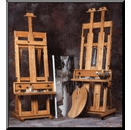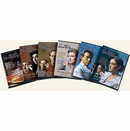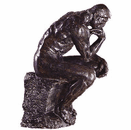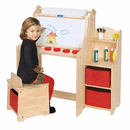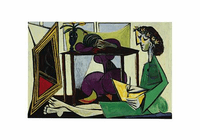5 TIPS FOR LEARNING TO SEE
By Carla O'Connor
In my workshops, I focus mostly on composition and design. As part of this lesson, I teach the commonly held design principles—rules, if you will—but after this brief lecture, I usually say something to the class akin to, "Now forget all of that." This is usually a surprise to my students. I can hear them murmuring all around me: "What does she mean?"
What I mean is learn those rules, then put them in the back of your mind, because what we're really going to be focusing on is the true path to that place where unique paintings and dynamic designs flow freely from you. To do that, you must learn how to see abstractly, how to see scenes and objects in many different ways. Once you actually see things as shapes and colors and lines, you reach a point where you can design and paint freely and naturally. It's only at this point that your unique personal vision starts to shine through.
Doodle a lot. Keep good paper and a good pen next to your phone and doodle. Write down the name of the person you're talking to and go over it, build shapes from it—whatever comes to your mind. Doodle whenever you can, and try to doodle on good paper. These become little paintings, or maybe inspirations for larger works. Doodles are little pieces of our subconscious—they're unique to us and represent purely our own creativity. Value them.
Think big and bold. Fill up the space on your paper. Work from edge to edge. Don't be shy and keep your painting contained in the middle. Stretch those lines out all the way. When I work with figures, I frequently fill up the entire space with the figure. This eliminates the need for a background—the central image is the dominant force.
Cut out distractions. Keep a "magic mat" handy as you paint. A magic mat is simply a white window mat you can lay on your painting-in-progress to check things out. The mat will serve as a buffer zone of sorts from the confusion around you. I like to use really wide mats (5 inches wide), especially if I'm working small (11x15 inches or smaller). The wide mat really makes the painting pop. On larger pieces you have to think more about balance, but I still use a 5-inch mat.
Be generous with paint. Don't use too much water. I paint a lot in opaque gouache, which shouldn't be thinned down too much anyway, but even with watercolor I encourage students to use more paint than water. Some of my students cringe when they see me squeeze out so much paint. I say, I'd rather put the paint on my paper than into my wash water!
Draw what you see. You have to learn to draw. No ifs, ands or buts! You can draw anything beautifully if you forget what it is ... just think of drawing as putting together the pieces of a puzzle.
Read more of O'Connor's article in the June 2004 Watercolor Handbook, a special issue of Watercolor Magic. You can purchase Watercolor Handbook on newsstands now or online.
* * *
Crosshatching can be the basis for building dark areas in a pen and ink drawing. It is achieved by doing exactly what the name indicates: Short lines are used in a cross pattern over previously drawn lines. The artist is able to build slowly and precisely the tone, depth, shadowing or texture he or she wants by simply adding lines. Gradation of tone is very easy to achieve with this slow and gradual building of detail.
In my workshops, I focus mostly on composition and design. As part of this lesson, I teach the commonly held design principles—rules, if you will—but after this brief lecture, I usually say something to the class akin to, "Now forget all of that." This is usually a surprise to my students. I can hear them murmuring all around me: "What does she mean?"
What I mean is learn those rules, then put them in the back of your mind, because what we're really going to be focusing on is the true path to that place where unique paintings and dynamic designs flow freely from you. To do that, you must learn how to see abstractly, how to see scenes and objects in many different ways. Once you actually see things as shapes and colors and lines, you reach a point where you can design and paint freely and naturally. It's only at this point that your unique personal vision starts to shine through.
Read more of O'Connor's article in the June 2004 Watercolor Handbook, a special issue of Watercolor Magic. You can purchase Watercolor Handbook on newsstands now or online.
* * *
Crosshatching can be the basis for building dark areas in a pen and ink drawing. It is achieved by doing exactly what the name indicates: Short lines are used in a cross pattern over previously drawn lines. The artist is able to build slowly and precisely the tone, depth, shadowing or texture he or she wants by simply adding lines. Gradation of tone is very easy to achieve with this slow and gradual building of detail.
Copyright © 2002-2025 Madison Art Shop™ LLC. All Rights Reserved.


